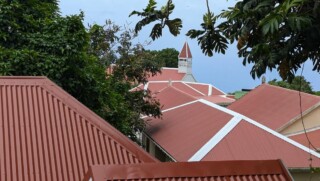West Indian Tree Fern rediscovered on Statia after 138 years
ORANJESTAD – Two researchers from Wageningen University and Research surveyed the steep inner slopes of the Quill Volcano. The field work is part of a long running study of the flora and vegetation of the Dutch Caribbean islands.
The steepness of these slopes and presence of loose rocks makes the inner slopes largely inaccessible. Consequently, little is known on the species that live there. By using remote techniques, the researchers tried to identify the plant species growing on the slopes and describe the vegetation. John Janssen and André van Proosdij worked in close cooperation with STENAPA during this and previous visits to Statia.
The team was able to identify most species found on the slopes. Not surprisingly, the slope vegetation clearly differs from any other vegetation type on the island. The sun-facing slopes harbor a sparse vegetation with yellow blossom (Tecoma stans), Monkey tail (Anthurium cordatum), Eyelash orchid (Epidendrum ciliare), Columnar cactus (Pilosocereus royenii), White cedar (Tabebuia heterophylla), Pudding white (Cissus verticillata), and Tillandsia’s. The North-facing slopes are more densely covered, due to the shade and lower drought-stress and show large clumps of Monkey tail (Anthurium cordatum), Clapper (Pitcairnia angustifolia), Wild balsam tree (Clusia major), Strangler figs (Ficus citrifolia), and several species of ferns. Particularly the large numbers of orchids and ferns are important, as on rocks accessible to goats these are eaten.
Spectacular
By far, the most spectacular discovery were five individuals of West Indian Tree Fern (Cyathea arborea). Tree ferns originate from the Carboniferous era, a geological period dating back 360-300 million years ago. This species was first recorded for Statia in 1885 but was never seen again. They were found growing on the lower part of steep, north-facing slopes, where the microclimate is cool and moist. For 138 years, this ancient plant species survived, in places truly inaccessible for humans and not visible from the main viewpoints. The presence of these rare tree ferns illustrates the high biodiversity in the Quill National Park and the importance of safeguarding the natural vegetation.
More endangered species to be discovered
“This discovery points out that on these most inaccessible steep slopes and the crater rim, more rare and critically endangered species are yet to be discovered”, stated Janssen and Van Proosdij. STENAPA and the WUR researchers intend to continue the exploration of these areas.












